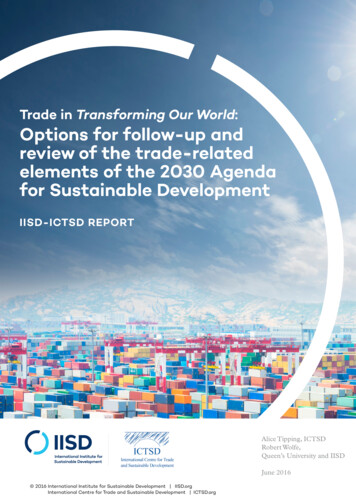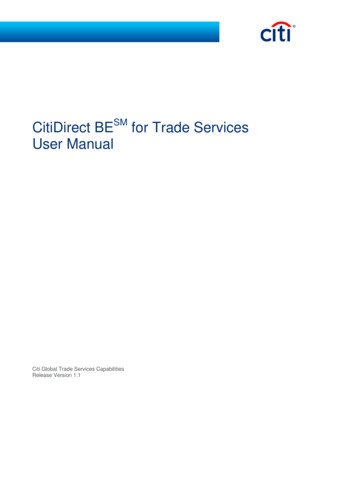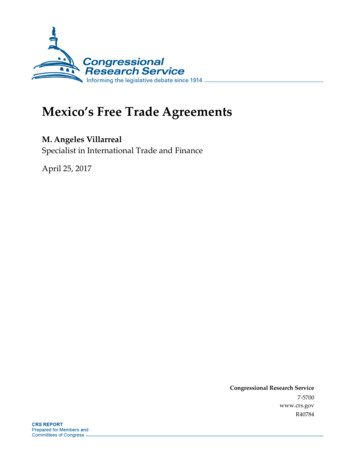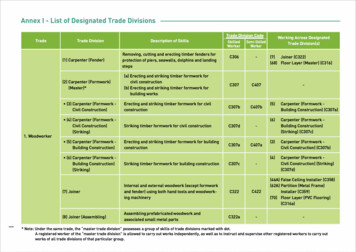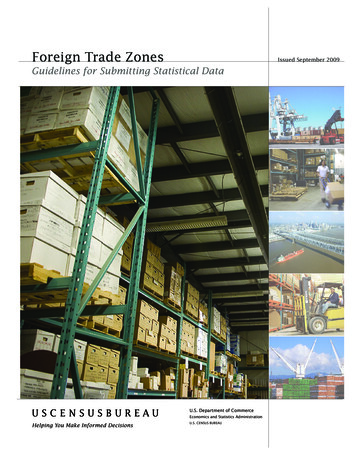
Transcription
Tools of the TradeA Guide to Designing andOperating a Cap and TradeProgram for Pollution Control
Tools of the Trade:A Guide To Designing andOperating a Cap and TradeProgram For Pollution ControlUnited States Environmental Protection AgencyOffice of Air and RadiationEPA430-B-03-002www.epa.gov/airmarketsJune 2003
Table of ContentsAcknowlegments .iiChapter 1: Introduction .1-1Introduction .1-1Purpose .1-1Structure .1-1Cap and Trade .1-2Chapter 2: Is Cap and Trade the Right Tool?.2-1Introduction .2-1General Assessment Issues .2-1Comparison of Cap and Trade and Other Policy Options .2-5Chapter 3: Developing a Cap and Trade Program .3-1Introduction .3-1Guiding Principles .3-1Establishing Legal Authority .3-2Creating an Emission Inventory .3-3Program Design Elements .3-4Other Design Considerations .3-25Chapter 4: How to Implement and Operate a Cap and Trade Program .4-1Introduction .4-1Integrated Information Systems .4-1Auditing and Verification .4-4Technical Support for Regulated Sources .4-5Administrative Costs Associated with Cap and Trade .4-6Chapter 5: Assessment and Communications.5-1Introduction .5-1Communicating Status and Results .5-1Communication Issues Unique to Emission Trading Programs .5-2Modes of Communication.5-5Continued Assessment .5-5Glossary of rences-1Appendix A: The Optimal Level of Pollution .A-1The Economics of Emission Trading .A-2Appendix B: Example Assessment of the Potential For Cap and Trade .B-1iiTable of Contents
Acknowledgmentshe U.S. Environmental Protection Agency (EPA) would like to acknowledge the many individual contribu tors to this document, without whose efforts this guidebook would not be complete. Although the com plete list of experts who have provided technical and editorial support is too long to list here, we would liketo thank some key contributors and reviewers who have played a significant role in developing this guidebook.In particular, we wish to acknowledge the efforts of the staff of the Clean Air Markets Division (CAMD) ofthe U.S. EPA – the division responsible for operating the U.S. SO2 Allowance and Ozone Transport Commission(OTC) NOx Budget Trading Programs. Many staff contributed to this guidebook, including Rona Birnbaum,Kevin Culligan, Katia Karousakis, Stephanie Grumet, Richard Haeuber, Melanie LaCount, Sasha Mackler,Brian McLean, Beth Murray, Sam Napolitano, and Sharon Saile. Special mention is due to Jennifer Macedoniaand Mary Shellabarger who did much of the planning and development of this guidebook. Joe Kruger andJeremy Schreifels compiled and edited the completed document.This guidebook benefited immensely from the comments and suggestions of a panel of external reviewers,including Dallas Burtraw, Resources for the Future; Andrzej Blachowicz, Center for Clean Air Policy; TomasChmelik, Czech Ministry of Environment; A. Denny Ellerman, Massachusetts Institute of Technology; ErikHaites, Margaree Consultants; Blas Pérez Henríquez, University of California-Berkeley; Stan Kolar, Center for CleanAir Policy; Nancy Seidman, Massachusetts Department of Environmental Protection; Jintian Yang, ChineseResearch Academy of Environmental Sciences; and Peter Zapfel, European Commission. We would like tothank each of them for their insightful comments and suggestions.We would also like to thank the staff at ERG for graphics and production support.TiiiAcknowledgements
1IntroductionIntroductionPurposeo ensure a cleaner, healthier environment, gov ernments are increasingly using market-basedpollution control approaches, such as emissiontrading, to reduce harmful emissions. The theory ofemission trading and the potential benefits of marketbased incentives relative to more traditional environ mental policy approaches are well established ineconomic and policy literature. Until recently, however,practical applications of emission trading programshave been relatively limited. In 1990, the United Statesenacted legislation to implement a comprehensivenational sulfur dioxide (SO2) program using a form ofemissions trading called “cap and trade.” The U.S.SO2 cap and trade program has proven to be highlyeffective from both an environmental and an economicstandpoint. The success of this program and othersthat followed has spurred interest from policymakers,regulating authorities, and business and environmentalorganizations. Today, emission trading mechanisms areincreasingly considered and used worldwide for thecost-effective management of national, regional, andglobal environmental problems, including acid rain,ground-level ozone, and climate change.This guidebook is intended as a reference for policymakers and regulators considering cap and trade as apolicy tool to control pollution. It is intended to besufficiently generic to apply to various pollutants andenvironmental concerns; however, it emphasizes capand trade to control emissions produced from station ary source combustion. In the United States, SO2 andNOx are controlled with cap and trade programs.These programs provide many illustrative examplesthat are described within this text.T1-1StructureThis guidebook is organized as follows: The introduction explains the policy tool knownas cap and trade. Chapter 2 provides guidance on how to determine if cap and trade is the right solution for aparticular problem and describes how it variesfrom other policy options, including other formsof emission trading.Introduction
Chapter 3 explains the process for developing acap and trade program. Chapter 4 explains how to implement and oper ate a cap and trade program. Chapter 5 discusses how to assess the results of acap and trade program and communicate them tothe public. Glossary of Terms and Acronyms contains defi nitions of the terms and abbreviations usedthroughout this guidebook. References contains a list of articles and paperscited in this guidebook. The Appendices contain additional technicaland reference information.Specific examples are provided throughout the text.These examples draw on the experience from cap andtrade programs, including the U.S. SO2 AllowanceTrading Program (also known as the Acid RainProgram), the Regional Clean Air Incentives Market(RECLAIM) in Southern California, the OzoneTransport Commission (OTC) Regional NOx TradingProgram in the Northeastern United States, and theUnited Kingdom’s emission trading program for carbon dioxide (CO2). These examples were selected toillustrate various aspects of cap and trade and are notintended to endorse controls on a specific pollutant.Cap and TradeCap and trade is a market-based policy tool for environ mental protection. A cap and trade program establishesan aggregate emission cap that specifies the maximumquantity of emissions authorized from sources includedin the program. The regulating authority of a cap andtrade program creates individual authorizations(“allowances”) to emit a specific quantity (e.g., 1 ton)of a pollutant. The total number of allowances equalsthe level of the cap. To be in compliance, each emis sion source must surrender allowances equal to its actu al emissions. It may buy or sell (trade) them with otheremissions sources or market participants. Each emissionsource can design its own compliance strategy – emis sion reductions and allowance purchases or sales – tominimize its compliance cost. And it can adjust itscompliance strategy in response to changes in technol ogy or market conditions without requiring governmentreview and approval.1-2How a Cap and Trade Program Works1. The regulating authority sets a cap on totalmass emissions for a group of sources for afixed compliance period (e.g., 1 year).2. The regulating authority divides the cap intoallowances, each representing an authoriza tion to emit a specific quantity of pollutant(e.g., 1 ton of SO2).3. The regulating authority distributesallowances.4. For the compliance period, each source meas ures and reports all of its emissions.5. At the end of the compliance period, eachsource must surrender allowances to cover thequantity of the pollutant it emitted.If a source does not hold sufficient allowances tocover its emissions, the regulating authority imposespenalties.Environmental CertaintyCap and trade programs offer a number of advantagesover more traditional approaches to environmental reg ulation. First and foremost, cap and trade programs canprovide a greater level of environmental certainty thanother environmental policy options. The cap, which isset by policymakers, the regulating authority, or anoth er governing body, represents a maximum amount ofallowable emissions that sources can emit. Penaltiesthat exceed the costs of compliance and consistent,effective enforcement deter sources from emittingbeyond the cap level. In contrast, traditional policyapproaches such as command-and-control regulationgenerally do not establish absolute limits on allowableemissions but rather rely on emission rates that canallow emissions to rise as utilization rises.With cap and trade programs, even new emissionsources may not increase the limits on emissions. Theregulating authority may require new entrants to pur chase or receive allocated allowances from the totalallowable emissions set by the cap (see Chapter 3 for adescription of different ways that new entrants may betreated). Thus, the emissions target is maintained andthe price of an allowance can adjust to reflect theincreased demand for allowances.A cap and trade program may also encouragesources to pursue earlier reductions of emissions thanwould have otherwise occurred, which can result inIntroduction
the earlier achievement of environmental and humanhealth benefits. This is a result of two primary drivers:first, the cap and associated allowance market createsa monetary value for allowances, providing sourceswith a tangible incentive to decrease emissions.Second, a cap and trade program can incorporate theflexibility of banking (see Chapter 4) to providesources with an additional incentive to reduce emis sions earlier than required. Banking allows sources tocarry over unused allowances for use in a later compli ance period when there might be more restrictiverequirements or higher expected costs to reduce emis sions. Essentially, banking gives sources some flexibil ity in the timing of emission reductions (i.e., temporalflexibility). This is in addition to flexibility given tosources in the location at which they make emissionreductions (i.e., spatial flexibility).Another environmental advantage of cap and tradeis improved accountability. Participating sources mustfully account for every ton of emissions by followingprotocols to ensure completeness, accuracy, and con sistency of emission measurement. This system con trasts with most environmental programs that basecompliance on periodic inspections and assumptionsthat equipment is functioning and the source is incompliance between inspections.Accurate measurement of emissions and timelyreporting are critical to the success of a cap and tradeprogram and the integrity of the cap. After emissionsdata and allowance transaction information are reported,the regulating authority can provide detailed or summa ry information to the public (e.g., on the Internet). Thistransparency, or access to information, can provide con fidence in the effectiveness of the program.Minimizing Control CostsIn addition to the environmental benefits of adoptinga cap and trade program, significant economic benefitsalso support the use of such a mechanism. Cap andtrade programs provide sources with flexibility in howthey achieve their emission target, which is uncommonunder traditional environmental policy approaches.The cap establishes the emission level for emissionsources; the sources, however, are provided with theflexibility of choosing how they want to abate theiremissions. Each source can choose to invest in abate ment equipment or energy efficiency measures, toswitch to fuel sources with no or reduced emissions, orto shutdown or reduce output from higher emittingsources. The regulating authority does not need toapprove each source’s compliance choices because thecap, accompanied by emission measurement andreporting requirements, enable the regulating authori ty to focus on assessing compliance results (i.e., ensur ing that each source has at least one allowance for eachunit of pollution emitted). Cap and trade programsalso allow sources to trade allowances, providing anadditional option for complying with the emissions target. Sources that have high marginal abatement costs(i.e., the cost of reducing the next unit of emissions)can purchase additionalallowances from sources thatFigure 1. Cost Minimization With Tradinghave low marginal abatementcosts. In this way, both buyersInitial Emissionsand sellers of allowances canbenefit. Sources with low costs10 tons10 tons10 tonscan reduce their emissionsAllowable limit(cap)below their allowance holdings7 tons5 tonsand earn revenues from selling3 tonstheir excess allowances – areward for better environmentalperformance. Sources with highcosts can purchase additionalallowances at a price that islower than the cost to reduce aAbatement Cost: 100/tonAbatement Cost: 80/tonAbatement Cost: 120/tonunit of pollution at their facilityReduction: 5 tonsReduction: 7 tonsReduction: 3 tons(see Figure 1). This outcome isconsistent with the “polluterpays” principle.Potential transfer of 2 allowances for 80- 120 each1-3Introduction
A well designed cap and trade program can alsoprovide continuous incentives for innovation in emis sion abatement. Because of the value attached toallowances. The value creates an economic incentiveto invest in research and development for emissionabatement options that can further reduce the costs ofattaining compliance.Finally, the cost-minimizing feature of cap and tradehas long-term environmental benefits. Driving downthe cost of reducing a unit of pollution means that poli cymakers and regulating authorities can set targets thatreduce more pollution at the same cost to society. Thissystem makes it economically and politically feasible toachieve greater environmental improvement.1-4Introduction
2Is Cap and Tradethe Right Tool?Introductionap and trade can be an effective tool to addressair pollution. However, it is not appropriate in allsituations or for all environmental problems.Policymakers should consider a number of importantissues before deciding whether cap and trade is appro priate. Prior to developing a cap and trade program,policymakers and other experts should determinewhether the nature of the environmental problem, aswell as the institutional capacity and political situation,is conducive to the successful establishment of such aprogram (Benkovic and Kruger, 2001).This section begins with a brief discussion of someof the general issues that must be assessed for anytype of emission reduction program. Next, the sectionexamines whether cap and trade can address a particu lar environmental problem. Finally, it compares capand trade to other types of policies including differentforms of emission trading.C2-1General AssessmentIssuesBefore making a decision about an emission reductionprogram, policymakers should assess a number of sci ence, technology, and other issues. For example, regardless of the type of program chosen, policymakers mustunderstand the nature of the environmental or healthproblem of concern, the pathways of exposure, the loca tion and magnitude of the sources that contribute to theproblem, and the emission reductions necessary toaddress the problem. Similarly, policymakers shouldhave answers to technical and economic questions suchas the cost, availability, and performance of control tech nologies. Although a full discussion of these questionsis beyond the scope of this manual, Appendix B sum marizes how some of these questions were addressedunder the U.S. SO2 Allowance Trading Program.Once policymakers have a thorough understandingof these issues and questions, they can determinewhether cap and trade is an appropriate tool to addressthe problem. The following sections outline some ofthe key considerations used to determine whether capand trade will be an effective program for a particularsituation.Is Cap and Trade the Right Tool?
Is Flexibility Appropriate?Cap and trade is premised on the notion that regula tors do not need to direct the type or location of spe cific emission reductions within a region. Instead,these programs set an overall target and let “the mar ket” determine where to make the most cost-effectivereductions. In some cases, however, it does matterwhere an emission reduction is made. For example,some toxic emissions may have primarily local healthimpacts in the area immediately surrounding a facility.Allowing such a facility to buy allowances from othersimilar facilities in the area may not fully address therisks caused by its emissions. It may make a situationworse by causing a “hotspot” if the cap does notrequire sufficient reductions to minimize or preventlocal impacts. In such a case, it may be necessary, froma public health standpoint, to impose source-specificcontrols and limit the flexibility inherent in an emis sion trading program.In general, the more a pollutant is uniformly dis persed over a larger geographic area, the more appro priate it is for the use of cap and trade.Even when the location of emissions does matter,cap and trade may be effective if the environmentalgoal can be met through emission reductions in a gen eral region. For example, a cap and trade program canreduce total loadings of a pollutant into the atmos phere, particularly if these pollutants are emitted bymany sources and transported over a large geographicregion. This was the case in the United States withthe SO2 Allowance Trading Program, which is intendedto reduce acid deposition in the Eastern United Statesand Canada. Similarly, cap and trade programs canaddress ambient air quality problems by reducingbackground levels of pollution that contribute toadverse air quality. For example, if there are prevailingwinds, it may be necessary to include emission sourcesupwind of the polluted area that could prevent downwind areas from meeting their ambient air qualitystandards. The NOx cap and trade programs in theNortheastern United States were designed to reducelong-range transport of NOx emissions that lead to theformation of ground-level ozone.Before designing cap and trade programs to addressemissions that are not uniformly mixed, it is necessaryto conduct an assessment of the possibility ofhotspots. Chapter 3 contains a discussion about waysto assess the potential for hotspots and how to developpolicies to avoid them if necessary. In such cases regu 2-2lating authorities may need to limit emissions at spe cific sources or limit trading to ensure that the program does not create hotspots and that it achieves theenvironmental objectives. It should be noted, howev er, that if a program requires too many trading restric tions to avoid hotspots, a more conventional regulatoryapproach to address the problem might be preferable.Do Sources Have DifferentControl Costs?Cap and trade programs make the most sense whenemission sources have different costs for reducingemissions (Newell and Stavins, 1997). These cost dif ferences may result from the age of the facilities, availability of technology, location, fuel use, and otherfactors. In the U.S. SO2 Allowance Trading Program,there was considerable diversity in emission reductioncosts because of differences in the age of power plantsand the proximity to low sulfur coal supplies (Stavins,1998). Where costs are different, there is “room for adeal,” because sources with high marginal abatementcosts have an incentive to buy allowances from sourceswith low marginal abatement costs. Conversely, ifaffected sources tend to be relatively homogenous,their marginal abatement costs may be approximatelyequal and there is little incentive for trading. In thiscase, a cap and trade program is not likely to yield asignificantly more cost-effective outcome than moretraditional types of regulation. Table 1 is a compilationof SO2 marginal control costs for sources in Taiyuan,China. The data were used to assess the feasibility ofusing cap and trade to reduce SO2 emissions. Thistype of analysis is critical to determining the merits ofusing cap and trade as a policy instrument.Are There Sufficient Sources?In general, cap and trade programs should includeenough sources to create an active market forallowances. If there are too few sources, there may befew opportunities for trading. In addition, even if thereare cost-effective trading opportunities in a programwith few sources, a market with few transactions couldmake potential sellers reluctant to part with theirexcess allowances. These potential sellers could beconcerned that if business conditions change and theyneed more allowances in the future, they will have dif ficulty purchasing them. They may instead hoardexcess allowances even though it might not appear toIs Cap and Trade the Right Tool?
they must follow national poli cies but are given considerableautonomy in implementation.2To the extent that the region ofControlSourceCost/tona cap and trade program covers(US )more than one jurisdiction, theauthorities should maintainTreat post-combustion gasTaiyuan District Heating 60some consistency in key designFlue gas desulfurization (FGD)Eastern Mountain Power Plant 80elements of the program. Toensure that the allowances areLower sulfur coal ( 1.3%)Taiyuan #1 and #2 Power Plants,consistent and fungible acrossTaiyuan Iron & Steel 100jurisdictions, cap and trade proFGD (simplified)Taiyuan #1 Power Plant* 240grams require common designelements, including standardsLimestone fuel additiveCoal Gasification Plant 130for determining applicability,emissions measurement and* In addition to unspecified costs paid through a grant from the government of Japan.Source: RFF, 2001reporting, recordkeeping,enforcement, and penalties fornon-compliance (Kinner, 2002).be in their economic interest to do so. Additionally,Thus, program designers should answer the followingwith fewer sources, there may be a concern that largerquestions:sources may exert market power and withhold Will provinces and municipalities be responsiveallowances from the market to drive up prices ofto directives, such as monitoring requirements,allowances.imposed by the national government or wouldThere is a tradeoff, however, in that the more numer they cooperate to form a collective effort toous the sources, the more complex and costly the capdevelop such requirements?and trade program may be to establish and operate. For Does the central government, or coalition ofexample, a cap and trade program for vehicles could belocal governments, have the capacity to enforceadministratively costly if there was a need to measurecompliance provisions and penalties throughoutand report emissions and enforce compliance at thethe entire trading region?1vehicle level. Technological advances, however, areOther design elements, such as allocation methodolo making it possible to cost-effectively expand participa gies for assigning the initial distribution fortion in cap and trade programs (e.g., computerized dataallowances, might be left to the provinces or munici tracking systems, improved emission measurement tech palities since the allocation methods have little envi nology (Kruger, et al., 2000)).ronmental impact. 3Table 1: Cost-Effectiveness of SO 2 Control Measures inTaiyuan, ChinaIs there Adequate Authority?Another important question government officials mustconsider is whether the relevant government entity hassufficient jurisdiction over the geographic area wherethey would implement the cap and trade program. Inmany countries, regional or local authorities are respon sible for implementing environmental programs. Often,1232-3Are there Adequate Politicaland Market Institutions?For the trading component of a cap and trade programto work, a country must have some of the same institu tions and incentives in place as those required for anytype of market to function. These include:Other environmental policy tools, or alternatively, the compliance obligation and allowance allocation at the vehicle manufacturer, fuel refiner ordistributor level, may be more appropriate in this case.For example, China’s provincial Environmental Protection Boards have the main responsibility for running air quality and other environmentalprograms. Similarly, in Slovakia there are 79 local districts that implement environmental and other programs.Allowing different provinces or municipalities to have different allocation schemes may have distributional economic impacts, such as favoringfirms within an
Cap and trade programs offer a number of advantages over more traditional approaches to environmental reg ulation. First and foremost, cap and trade programs can provide a greater level of environmental certainty than other environmental policy options. The cap, which is

